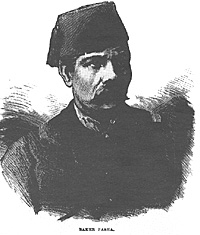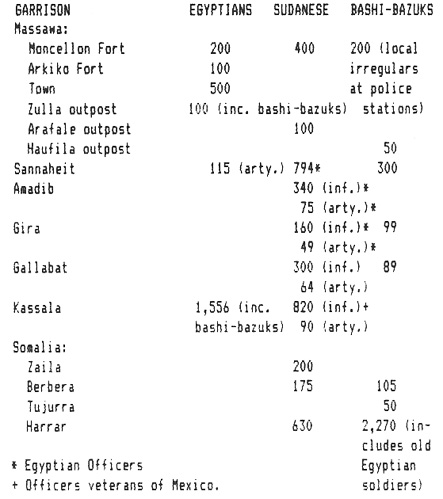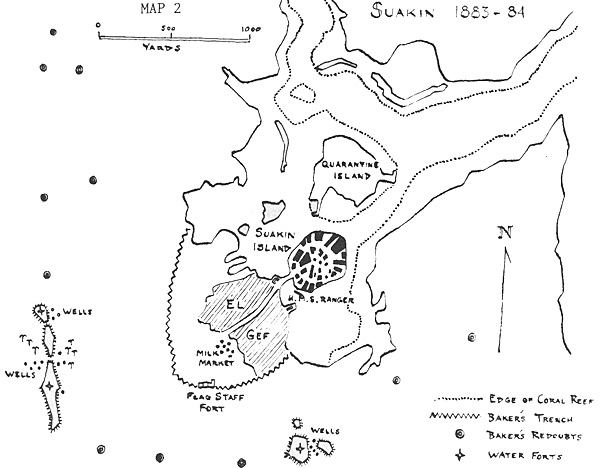 Note: This is the second part of an
extended series on the wars in the Eastern
Sudan which will appear in S&S on an occasional
basis. Part one covered the rise of Osman
Digna. Future parts will cover the campaigns of
1884-5, the skirmishes between 1885-8, the
reoccupation of Tokar in 1891, and the securing
of the border in 1898.
Note: This is the second part of an
extended series on the wars in the Eastern
Sudan which will appear in S&S on an occasional
basis. Part one covered the rise of Osman
Digna. Future parts will cover the campaigns of
1884-5, the skirmishes between 1885-8, the
reoccupation of Tokar in 1891, and the securing
of the border in 1898.
With Mahaud Tahir Pasha's defeat at Andetteib (El Teb) on 5 November 1883 the Egyptian government was forced to bring in reinforcements to help secure Suakin from attack.
Baker Pasha
The reinforcements case from two main sources: from other Red Sea garrisons in Abyssinia and Somalia, and from Egypt itself. By the end of 1983 the Abyssinian and Somalia troops were deployed as follows (Wylde: 45-7 [a complete list of Egyptian infantry units is unavailable]):
 The total force in Abyssinia consisted
of 1,015 Egyptians, 1,918 Sudanese and 649
irregulars (some of whom were recruited
locally). The largest garrisons were at Massawa
and Sannaheit. Somalia totalled 1,005 Sudanese
and 2,425 irregulars, some of which were old
Egyptian soldiers. The garrisons at Gallabat
and Kassala, both being in the Sudan, were
effectively isolated from Suakin and could not
be drawn on.
The total force in Abyssinia consisted
of 1,015 Egyptians, 1,918 Sudanese and 649
irregulars (some of whom were recruited
locally). The largest garrisons were at Massawa
and Sannaheit. Somalia totalled 1,005 Sudanese
and 2,425 irregulars, some of which were old
Egyptian soldiers. The garrisons at Gallabat
and Kassala, both being in the Sudan, were
effectively isolated from Suakin and could not
be drawn on.
The Somali garrisons were so far away that they were not evacuated in time to be used in Baker's campaign. That left only about 3,000 regulars from Abyssinia that could be brought to Suakin, a force too small to be effective. The main body had to come from Egypt.
In Egypt after Tel-el-Kebir the gendarmerie was raised from old soldiers in the Egyptian army to act as a semimilitary force in the provinces, guarding the border and patrolling the desert. They were given the same uniform and equipment as the old army, and up to 1883 officers were interchangeable between the army and the gendarmerie (Haggard: 24; Sartorius: 72, 77). General Valentine Baker was given command of the gendarmerie, a post he held until his death in 1887.
Baker had served in the Turkish army during the Russo-Turkish War of 1877-8, after having been dismissed from the British army for the attempted rape of a woman in a railway carriage in 1875. He rose to the rank of fariq before being seconded to the Egyptian army where he was first proposed to take overall command. The scandal of his dismissal followed his and Queen Victoria, among others, opposed his appointment. He got the gendarmerie instead.
The gendarmerie originally totalled 6,000 men, organized into companies of 50 with three officers each. There Were 1,600 mounted gendarmes, 500 'Turks' and 400 "European" police (all natives of Egypt) for Cairo and Alexandria, and 3,500 other gendarmes. But in 1883 it was remodelled along the lines of the Irish Constabulary and the number of officers and horses were reduced. The Cairo and Alexandria battalions were then recruited entirely from the NCOs of the old army (Sartorius: 74, 77, 80).
Baker was reluctant to take command of an expeditionary force to Suakin but agreed to do so when it was decided to raise a supplementary force of Turkish bashi-bazuks as well as some bazinqirs (slave riflemen) under Zubair Rahma Pasha.
Before these troops could arrive some
600 Sudanese from Massawa (not included in the
above figures) under Col. Kassis Effendi
reached Suakin and were immediately sent out
along with 200 Egyptian soldiers, 50 bashi-bazuk cavalry and one gun under Major Izzet
Effendi and Capt. Ibrahim Effendi to capture
Osman Digna.
(1)
While the troops were watering, some
3,000 ansar suddenly attacked the rear face.
The cavalry fled into the Sudanese in an
attempt to get into the square, and then the
Egyptians broke and fled into the backs of the
Sudanese. The cavalry and the two Effendis
retreated, but the Sudanese fought on for some
hours, back to back, until almost all were
killed.
(2)
The situation in Suakin was critical.
The gun-vessel H.M.S. Ranger under Commander
W.E. Darwall had been sent to Suakin in
November 1883 and now became the town's main
defence, moored along the causeway connecting
the town to the mainland (Clowes: 350). Suakin
itself contained only 300 mixed troops, mostly
"old soldiers of the garrison", 2 Krupps, 3
mountain guns and some lBth Century smooth-bore
cannons (Wylde: 7; Sartorius: 104). The Ranger
was joined by the corvette Carysfort (Capt.
Walter Stewart), the torpedo-depot ship Hecla
(Capt. A.K. Wilson), and eventually the H.M.S.
Coquette (Capt. Alexander Plantagenet) and the
H.M.S. Woodlark from Aden (Clowes: 350-1).
Baker's chief of staff, Col. Sartorius, arrived
with the first batch of 650 gendarmes an 8
December 1883, and Suakin, at least, was
considered secure (Sartorius: 92; Royle: 104).
The force that set out from Egypt in
stages underwent a number of shifts in
composition. Six hundred from the Alexandria
battalion were sent and 800 from the Cairo
battalion, but 280 Cairenes deserted on the way
and only 520 arrived in Suakin. A number of
Turks were also recruited but only 100 obeyed
the summons (Sartorius: 86).
Throughout the month of December various
batches of gendarmes arrived in Suakin. There
was a small contingent of 'European' police
(about 50) under Major Maletta, an Italian
(Sartorius: 147). The depletion of gendarmerie
in Egypt itself meant that new recruits had to
be found to increase their ranks quickly. These
were all 'Turks' (Albanians, Circassians, etc.)
living in Egypt, same 500 in all, who were first
instructed in drill only after arriving in
Suakin (Sartorius: 156, 167, 211).
It had been decided to augment the
gendarmes by raising some 1,600 semi-regular
black riflemen, or bazingirs as they were known
in the southern provinces of the Sudan, and
send them to Suakin under the command of Zubair
Rahma Pasha. Zubair had been an ivory and slave
merchant an a far larger scale than Osman Digna
and had conquered such of Bahr al-Ghazal and
Dar Fur with his own bands of slave riflemen in
the 1860's and 1870's. He had lost his prize of
Dar Fur to the government and found himself a
permanent 'guest' of the Khedive in Cairo for
his pains. His son had been executed by Sessi
during a revolt during Gordon's first governor-generalship.
Because of his success with slave armies
it was first thought that he would be equally
successful with a smaller force raised and
trained in a shorter period, but then it was
decided politically unwise to send Zubair
himself to Suakin. It was doubtful that he
would have achieved such even if he had gone,
His nephew, sent as an emissary to Osman Digna
in December, failed completely to interest any
of the Beia in cooing over to Zubair and the
Egyptian government.
Zubair paraded his first battalion of
bazinqirs in front of the Khedive in Cairo on
the 2nd of January, 1884. There were delays in
their departure because of lack of transport,
but finally six companies, along with their
families, under the command of Khalil Ali were
dispatched from Egypt an the 16th of January,
arriving in Suakin a few days later (Royle: 104-
5; Sartorius: 199, 208).
The second battalion was placed under
the command of a well-educated, French-speaking
Turkish officer who complained both of the
quality of the retired Egyptian officers and
NCOs allotted to the battalion, and of the
quality of the troops themselves. He protested
that his men were untrained and unfamiliar with
their firearms, but because Baker had requested
the immediate dispatch of all men, trained and
untrained, they too embarked on 20 January and
arrived at Suakin by the end of the month
(Sartorius: 209; Royle: 105).
In all there were some 1,200 bazinqirs
sent to the Eastern Sudan, but unlike the
experienced riflemen who had fought in the
Southern Sudan and who were soon to join the
Mahdi's army, they were bazinqir in name only.
Despite the fact that the reinforcements
from Egypt were supposed to provide the main
force of operations in the Eastern Sudan, their
lack of training and experience forced the
commanders of the new expeditionary force to
rely even more heavily on the experienced soldiers they
were ostensibly coming to reinforce. These fell
into three main groups: the 'old soldiers' of
the Suakin garrison, the local bashi-bazuk
irregulars, and the regular troops in the
Abyssinian and Somali garrisons.
The "old soldiers" were never a credible
force. They numbered no tore than 320 by the
beginning of February, were given no regular
uniform and were detailed mainly to guard the
gates of the town (Sartorius: 104, 225).
The bashi-bazuks were potentially more
useful, but in fact provided no core of
disciplined men around which the rest of the
force could be organized. They were all
Albanians and were not normally drilled.
When Col. Sartorius tried to institute
regular drill, they refused and had to be
disarmed by four companies of the Alexandria
battalion and their leaders flogged before
training could proceed. Some of their numbers
included young boys and old, deaf, blind and
lame men who had to be sent back to Egypt.
Their numbers were expanded, however, by new
batches from Egypt. Some had preceded Sartorius
to Suakin and more came afterwards. The last
batch of 200 arrived at Trinkitat direct from
Suez only two days before the 2nd Battle of El
Teb. The commander of all bashi-bazuks was
Yusuf Bey, and they were employed in a number
of reconnaissances around Suakin before the
final march to Tokar (Sartorius: 96, 128-9,
139, 147, 151).
There was only one contingent of bashi-
bazuks which did command respect. These were
local Abyssinian hillsen attached to the
Massawa garrison and outposts. They were good
at skirmish fighting, but as they were locally
recruited in Abyssinia they were not available
for the Tokar campaign, despite Baker's wish
that he could have brought thee along (Wylde:
109). Only 24 came as volunteers to Suakin, a
taken unit entirely (Sartorius: 214).
This left the regulars of the Abyssinian
garrisons. They were needed desperately since
Col. Sartorius decided soon after his arrival
that Muhammad Tawfiq at Sinkat should be
relieved before the advance to Tokar
(Sartoriusi 137-8).
Sinkat was besieged by at least 4,000
men, though some reports put the besiegers at
11,000 (Sartorius: 137-8; Colville: 19).
Against this Tawfiq had to hold the town with
only 150 bashi-bazuks, 300 Egyptian infantry
and 32 gunners (Sartorius: 107). But Sulaisan
Pasha assured Baker that Tokar was in more
urgent need of relief, so Sinkat was left to
fend for itself while the Tokar relief force
was gathered together.
Baker and his staff assembled in Suakin
throughout the month of December. With Baker
were Major-General (Egyptian rank) Sartorius
Pasha (2nd in command), Col. Abd &I-Rassak
(Egyptian Chief of Staff), Lt.-Col. Fitzroy Hay
(European Chief of Staff), Major Harvey, 42nd
Highlanders (ADC to Baker), Lt.-Col. Morice
Bey, RMLI (Paymaster), and Dr. Leslie (medical
department). Sartorius was commander of the Ist
division and had under his Lt.-Col. Harrington
(Rifle Brigade) as chief of divisional staff,
Major Izzat Effendi, and Capt. Goodall as ADC.
Major G.D. Giles (the war artist) commanded the
"Turkish" (bashi-bazuk) cavalry, while Major
Holroyd commanded the "Turkish" infantry. Capt.
Forrestier Walker, who had served with Hicks
before the march into Kordofan, now case as the
correspondent of the Daily News and
doubled as commander of artillery, while Col.
Frederick Burnaby came along for the ride
(Sartorius: 85-6, 157; Haggard: 126-7; Royle:
102).
Baker had at his disposal the Egyptian
gunboats Tor and Gefferiah, along with the
troopships Zagazig, Tantah, Mahallah, Mansurah,
and the small paddle steamer Deb el-Bar. The
Royal Navy was represented by a squadron under
Admiral Hewitt, now consisting of the H.M.S.
Euryalus (flagship), Sphinx, Ranger, Woodlark
and Coquette.
To strengthen his force Baker
transferred the Sudanese soldiers of Massawa
and Sannaheit to Suakin, replacing thee with
some of the Egyptian infantry. He could not
wait for the arrival of the Harrar garrison,
and Sulaiman Pasha ordered the return of one
batch of Sudanese troops to Massewa for fear of
an Abyssinian attack (Wylde: 53; Sartorius:
153).
Fortifications
Suakin itself had to be fortified. The
main town was an an island, linked to the
mainland by a causeway. At the end of the
causeway wad the market town of El Geif. Just
outside the milk market was an old three-roomed
stone fort, surrounded by a trench and
earthwork, containing two Krupp guns, three
mountain guns and some 18th Century
ssoothbores.
Next to the fort was a stone barrack which
could hold up to 400 men. To the north of El Geif
was an unfortified mud and stone barrack which
could hold two companies. Beyond this was a police
station, inhabited only by day. There were no defences to the
south, facing Tasaai and Tokar, The army headquarters tent was
pitched in the silk market, and the troops were stationed around El
Beif. There were no forts guarding the wells outside the town
(Wylde: 7-8).
In December, after Sartarius' arrival, a four foot deep,
three foot wide trench was dug around El Geif, with a parapet of
about five to six feet high. Six foot long stakes were placed in the
trench. The trench connected up a series of small forts, which
were detached buildings surrounded by ditches.
A zariba of old sisasa bushes was placed around the
outer edge of the parapet. Sartorius established the headquarters
of the 1st division in a small two-storey building near the flag staff,
with a small barrack occupied by the European police. Forts were
placed at the wells, and at night they hung lanterns out an the
town side so as not to be fired on. Baker added another series of
small forts outside the lines in January 1884, and this kept the
ansar further away from the town as they did not want to get
caught between the redoubts and the main fortifications
(Sartorius: 126-7, 131, 186, 197).
Mahdist pressure on the various garrisons of the Red
Sea continued. On 20 December 1883 the ansar seized part of
the town outside Tokar, but Ibrahim Markavi, the garrison
commander, drove thee off (Sartorius: 180).
On the same day, Sartorius, Major Giles and Augustus
Wylde (the British consul at Suakin) made a reconnaissance
against the Hadendowa with 250 cavalry. They managed to
capture some 260 camels and a number of other livestock, but
learned later that they had seized the herds of some of their
"friendlies" (Sartarius: 149-52).
About a month later, on 22 January 1884, Baker himself
led some 300 cavalry an another reconnaisance and also
captured a good deal of cattle but had to retire to Suakin with the
Beja camelmen harrying him part of the way (Sartorius; 201).
 The column set out on the night of 1st-2nd December and came upon a small party of
Mahdists at the wells of Tamanieb in the
morning. The cavalry had stayed close to the
flanks of the column all the while and had done
no scouting. The Sudanese infantry opened fire
on the ansar, dispersing thee. The square then
moved up, occupying the wells, with the
Sudanese forming three sides of the square and
the Egyptians forming the rear face.
The column set out on the night of 1st-2nd December and came upon a small party of
Mahdists at the wells of Tamanieb in the
morning. The cavalry had stayed close to the
flanks of the column all the while and had done
no scouting. The Sudanese infantry opened fire
on the ansar, dispersing thee. The square then
moved up, occupying the wells, with the
Sudanese forming three sides of the square and
the Egyptians forming the rear face.

Wars in Eastern Sudan Part 2: Baker & El Teb
- Re-inforcements
Second Battle of El Teb
Troops and Tactics
Uniforms
Illustration: Egyptian Troops from Eastern Sudan (166K)
Wargame Ideas
Footnotes and Bibliography
Back to Table of Contents -- Savage and Soldier Vol. XIX No. 2
Back to Savage and Soldier List of Issues
Back to MagWeb Magazine List
© Copyright 1987 by Milton Soong.
This article appears in MagWeb.com (Magazine Web) on the Internet World Wide Web.
Other articles from military history and related magazines are available at http://www.magweb.com